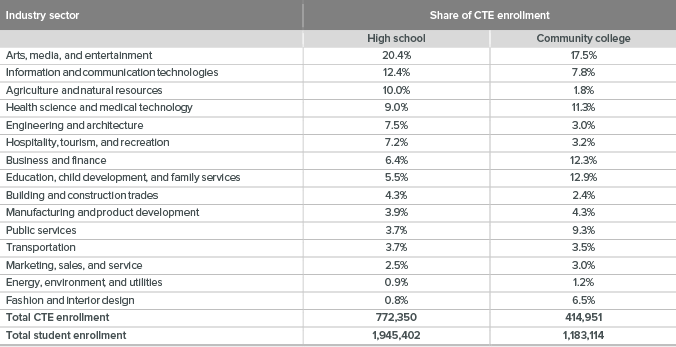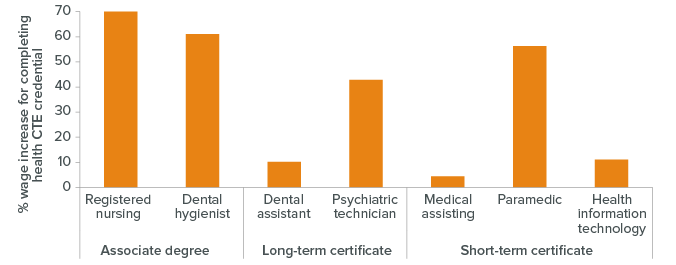- Career technical education is critical to meeting the state’s workforce needs.
If current trends continue, roughly one-third of new jobs in California will require some training beyond high school but less than a four-year degree. Career technical education (CTE), also known as vocational training, connects students to these career opportunities by providing industry-based skills. In addition to improving career options in the short term, CTE can provide pathways to higher education; for example, about a third of high school CTE courses meet the admission requirements for California’s public four-year universities. - Public high schools and community colleges are the primary providers of CTE.
During the 2016–17 school year, close to 800,000 high school students (45%) enrolled in a CTE course. Arts and media courses are especially popular, as are CTE courses in information technology, agriculture, and health. At community colleges, nearly 420,000 students (35%) participated in CTE. Arts and media is once again the most popular industry sector, followed by education, business, health, and public services. While for-profit colleges also offer CTE training, enrollments have declined in recent years.
Enrollment in CTE programs varies across institutions and industry sectors

SOURCE: California Department of Education, 2016–17. California Community College Chancellor’s Office Data Mart, 2016–17.
NOTE: Industry sector refers to the 15 “career clusters” identified by the California Department of Education. Community college enrollment numbers are based on full-time equivalent (FTE) enrollments and categorized into industry sectors based on Taxonomy of Program (TOP) codes.
- Research indicates certain kinds of CTE training can improve employment and wages.
Several recent studies have found that CTE credentials from community colleges can increase earnings, but gains vary widely across different types of credentials. Across sectors, health credentials tend to confer the largest wage increases (as high as 70%), though gains are smaller for shorter training programs. In contrast, recent research on for-profit colleges finds no improvement in earnings or employment following a CTE credential in most fields. While evidence on high school training is more limited, some studies have shown increased graduation rates for CTE students, and CTE-based career academies have been linked to higher employment and earnings.
Many CTE credentials in health lead to wage gains, but benefits vary across programs

SOURCE: Adapted from Bohn, McConville, and Gibson, Career Technical Education in Health (PPIC, 2016).
NOTE: With the exception of medical assisting, the wage return for all credentials shown is significantly different from zero.
- Workforce demand and equitable access are key considerations for effective CTE programs.
Creating pathways between high school CTE courses and community college programs—as well as between short- and long-term college programs—is important to meeting workforce needs in high-demand fields and improving career outcomes. In addition, CTE enrollment should represent the diversity of California’s population. While CTE students generally reflect the demographics of the overall student population, Asian American, Latino, and female students are slightly underrepresented in CTE at both high schools and community colleges. However, enrollment trends vary widely across sectors; for example, male students are underrepresented in health and education CTE courses. - Both state and federal governments provide support for CTE.
The vast majority of CTE funding for public high schools and community colleges comes from state apportionment funds. Federal funding sources, such as the Perkins Act, also provide support to CTE in both high schools and community colleges. In addition, financial aid, which offsets students’ cost of attendance, is an important component of public investment in postsecondary CTE training: the state’s Cal Grant C program supports CTE at community colleges, while federal financial aid can assist those enrolled in CTE at for-profit colleges. - Evaluating recent efforts to strengthen CTE requires a more robust data system.
Recent state investments, including the California Career Pathways Trust and the CTE Incentive Grants program, have created and expanded CTE programs. California policymakers have also established the Strong Workforce Program, which provides $200 million annually to support CTE at community colleges. At the federal level, the Perkins Act is currently being reauthorized and received a total of $1.2 billion (a 7% increase) in the most recent federal spending bill. Given its numerous efforts to bolster workforce training, the state should better link educational and employment data to ensure progress is being made and to help identify the policies and programs that produce the best outcomes for students and employers.
Topics
Access Completion Equity Higher Education K–12 Education Workforce Needs

